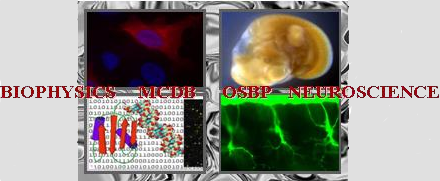Poster abstracts
Poster number 24 submitted by David Heisler
A novel mechanism of toxicity amplification: ACD toxin-produced actin oligomers poison formin controlled actin polymerization
David B Heisler (Ohio State Biochemistry Program and the Department of Chemistry and Biochemistry), Elena Kudryashova, Dmitry O. Grinevich (Department of Chemistry and Biochemistry, The Ohio State University), Cristian Suarez, Jonathan D. Winkelman (Department of Molecular Genetics and Cell Biology, The University of Chicago), Konstantin G. Birukov, Sainath R. Kotha (Section of Pulmonary and Critical Care and Lung Injury Center and Lipid Signaling and Lipidomics Laboratory, Division of Pulmonary, Allergy, Critical Care and Sleep Medicine, Department of Medicine,), Dimitrios Vavylonis (Department of Physics, Lehigh University), David Kovar (Departments of Molecular Genetics and Cell Biology and of Biochemistry and Molecular Biology, The University of Chicago)
Abstract:
Bacterial toxins are the deadliest compounds on the planet; a single copy is capable of compromising a host cell. Amplification of toxicity is typically achieved by enzymatically targeting signaling cascades or inhibiting vital host proteins found in relatively few copies. Conversely, the major cytoskeletal protein actin is a common target for toxins, and it is not clear how actin-targeting toxins achieve high efficiency. The actin crosslinking domain (ACD) catalyzes the formation of an amide bond between actin monomers, forming actin oligomers. It was believed that ACD toxicity stems from the slow failure of the cytoskeleton due to the gradual accumulation of these non-functional actin oligomers. We found that ACD is not required to crosslink all actin in the cell; suggesting that low doese of ACD-crosslinked oligomers are toxic. Since actin-binding domains of actin-regulatory proteins are organized in tandems, these proteins can potentially bind actin oligomers with abnormally high affinities. Formins, a family of actin binding proteins, nucleate filaments and, through their tandem poly-proline stretches, bind profilin-actin complexes to accelerate filament elongation. We found that formins preferentially bind crosslinked oligomers and are inhibited by sub-nanomolar concentrations of oligomers as revealed on the single filament level by total internal fluorescence reflection microscopy. In the presence of profilin, the oligomers caused reversible blocks of elongation of formin-controlled filaments. Mathematical modeling revealed that the oligomers potently inhibit both nucleation and elongation of formin-controlled actin assembly. Our findings indicate that ACD employs a novel toxicity mechanism by converting actin into highly toxic oligomers to targeting key regulators of actin dynamics.
Keywords: Actin, Toxins, Cell biology
